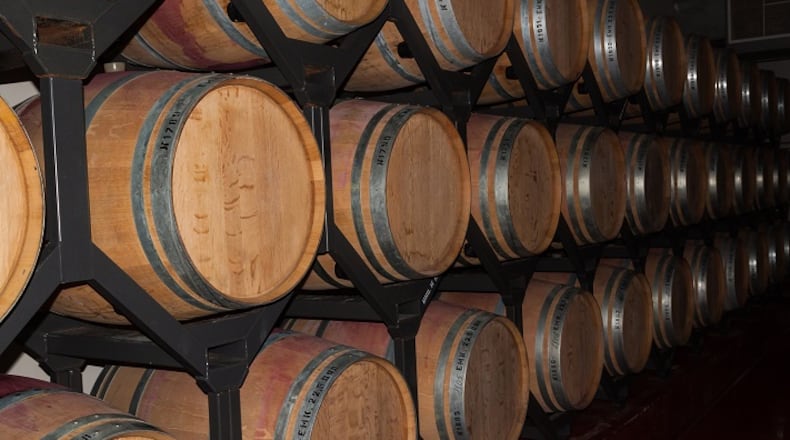Barrels (most often made of oak from France or the United States) can contribute a lot of different things to wine, and not all of them are automatically good. When you consider the many expressions of wine either aged or fermented in wooden barrels (or less-expensive alternatives to barrels, like oak chips or staves), you can start to home in on your wine preferences and figure out exactly what you like (or don’t like) about the effect of wood on wine.
Getting to that point will require a little legwork beyond reading the back labels of wine bottles. Sometimes you’ll find information about what kind of wood treatment the wine has undergone, but more often than not, you won’t. A trusted wine seller can help you focus your wood-and-wine leanings, and you can always research specific wines — some regions legally require oak aging, such as Rioja, Barolo and Brunello — but this is an inexact science. In other words, you’ll never really know until you actually taste the wine. It’s alive, affected by dozens of factors, and no two bottles — let alone vintages — are exactly the same.
Wood can be a great aroma-, flavor- or character-collaborator with myriad grape varieties, particularly two of the world’s most widespread: cabernet sauvignon and chardonnay. But all kinds of fine wines spend time maturing in barrels before they are bottled.
You have surely smelled and tasted the effects of wood aging. Aromas of cedar or cigar box? They came from wood. That might be obvious, but what about notes of vanilla, caramel, coconut, spice, clove, coffee or smoke? All of those, and more, can come from wood too.
Some of the things winemakers consider when choosing the right barrels for their wines are the size and age of the barrels, the level of “toast” the barrels underwent when they were heated and bent into shape, how the wood was treated before it was made into barrels, and the type of wood itself. Winemakers go so far as to consider exactly where the oak was grown and which cooperage turned it into barrels. They experiment. And their decisions can vary with each style of wine they produce.
Besides imparting aromas and flavor to wine, oak barrels can also soften a wine’s sharp edges via oxygenation, as air makes its way through the porous wood from the outside. Wine in a barrel also evaporates, further concentrating it. The longer a wine ages, the more concentrated it becomes and the more it loses its fruit. If a wine is fresh and light and fruity, there’s a good chance it didn’t spend much time in contact with oak. So there is a trade-off, and winemakers routinely taste their aging wines to decide how far they are willing to let them go in one direction or the other.
Oak barrels can also contribute mouth-drying tannins to a wine. The lighter the toast, the more those tannins (and aromas and flavors) can come through. The wooden staves used to make barrels are heated, often toasted over fire, so they can be bent into shape. The lightest toast would allow more of the characteristics of the wood to come through and integrate with the wine. A medium toast would allow less tannin and less of the wood’s oakiness, but perhaps more vanilla flavors. A heavy toast would allow the least amount of tannin, but darker aromas and flavors like coffee and campfire smoke.
Regardless of toast, newer barrels impart more of everything they have to offer than barrels that have been used in prior vintages. With that in mind, winemakers often use different types of barrels (i.e., different types of oak, toast and age) for the same wine. This is where, in your legwork, you might see descriptions of how long a wine was aged in barrels, what percentage of them were French or American, and what percentage of them were new or used (i.e., “Aged 18 months in French oak barrels, 100 percent new”). French oak generally imparts more tannin but less aggressive aroma and flavor notes than American oak.
In lieu of stainless steel tanks, oak barrels can also be used in the fermentation process, as they famously are with chardonnay in the Burgundy region of France. Barrel sizes can vary, but the widely accepted standard size holds 225 liters (59 gallons) and is known as a Bordeaux barrel, aka “barrique.” The Burgundy barrel is just slightly larger. To that end, smaller barrels impart more concentrated flavors, as there’s more wine in contact with more wood, while wines aged in larger barrels are subtler.
Barrels are expensive, and when winemakers want to give their wines oak treatment without spending money on actual barrels, they sometimes use oak staves (wooden slats dipped into the wine) or oak chips. Aging or fermenting wine in wood can be like seasoning food as you cook. When the seasoning is the overwhelming flavor, it’s too much. When it is well-integrated, it can make the dish, or the wine, better.
If you’re someone who loves an oaky, vanilla blast with each whiff and sip, seek out those wines. If you don’t like too much of that in your wine, now you’re at least on your way to figuring out how to avoid it — or discovering where your oak sweet spot is. Of course it might vary with different wine styles. You’re up to the task of getting to the bottom of this one, though.
About the Author

